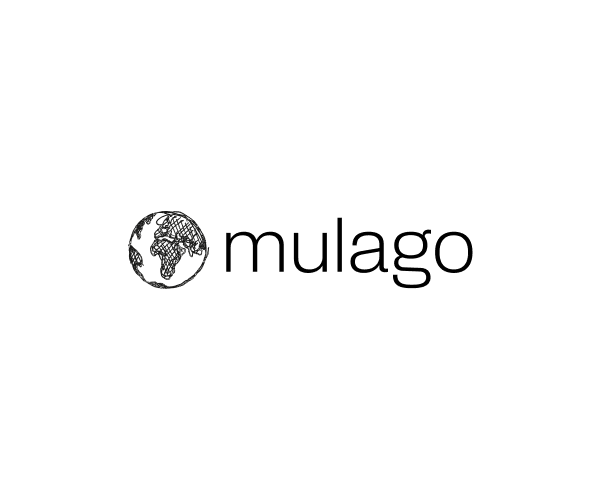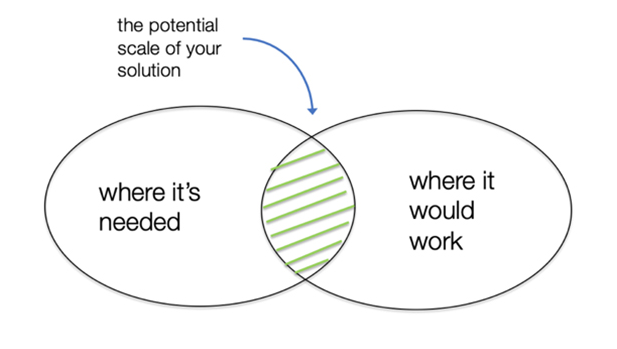Big Enough. Simple Enough. Cheap Enough.
Daunting social problems need scalable solutions. Here’s how to know if you’ve got one.


Our problems are big. Our resources are finite. The clock is ticking. An incremental, project-by-project approach won’t cut it. We need ideas that can go big. We need scalable solutions.
Scale isn’t just another word for growth. Scale is about busting out of a linear trajectory into an ever-steepening—exponential, even—curve of impact over time. A scalable solution is one that has the potential to make a big dent in a big social problem, maybe even solve the whole thing.
Our job at Mulago is to find and fund organizations with scalable solutions that meet the basic needs of the very poor. When you make your living looking for scalable ideas, you need a systematic way to know one when you see one. Over time, we’ve developed an effective tool in the form of three deceptively simple questions. We ask: Hey, is this solution:
- Big enough?
- Simple enough?
- Cheap enough?
So what the hell is “enough?” Fair question. The answer depends on your “doer” and “payer”: You need to know who is going to replicate your solution—“do it”—at big scale and who is going to pay for it. You can’t answer any of the “enough” questions without knowing who will someday do the heavy lifting at problem-solving scale.
We first wrote about the doer and payer in 2015, but it’s worth a quick summary. First, there are really only four potential doers at scale:
- You. You develop a big enough organization to replicate at scale.
- Businesses. Lots of firms replicate your for-profit solution.
- NGOs. Lots of organizations deliver your nonprofit solution.
- Governments. Ministries and agencies deliver your solution as part of their services.
In the vast majority of cases, going to scale means that a solution has to escape the confines of the originating organization; “you” is rarely the most promising answer. There might be multiple doers midway through the journey to scale, but there is almost always one that ultimately predominates as you get into really big numbers. For example, you might have a community health worker model that some other NGOs initially replicate, but you know the jackpot is for the ministry of health to adopt and implement it as policy. You might grow a pretty big business, but to solve the problem still requires that a bunch more businesses deliver some version of your solution.
As for payers, there are again only four:
- Customers: when you’ve got a for-profit solution
- Private Philanthropy: when your solution requires some finite subsidy
- Government: budget allocation of tax revenues or Big Aid
- Big Aid: multilateral and bilateral funding directly to NGOs
As with doers, you may go through a sequence of overlapping payers. Perhaps philanthropy gets you started, then you transition to Big Aid down the line. But it’s almost always the case that one payer will eventually do the heavy lifting.
Getting to scale always involves getting your doer and payer right. It’s not always easy for an early-stage organization to figure it out, but you can’t assess scalability without it. The rare and lucky organization lands on the right doer and payer without identifying and designing toward them early on, but the vast majority will either: a) fail to scale, or b) spend years meandering toward something they could have headed to straightaway.
So, armed with a vision of scale and a best guess as to doer and payer, we can go back to our three questions.
1. Is It Big Enough?
This is about the potential scope of your solution. Big enough means big enough to matter given the scale of the problem (or, perhaps, the scale of your ambitions). Here’s a useful Venn diagram:

The overlap between the two circles represents the “addressable market” for your solution. To figure it out, you first have to understand the nature and magnitude of the problem you are taking on and where the need is most acute. Next you have to figure where your solution would work. You may already know the answer, or you may be in the middle of learning it the hard way. Think of it as a list of elements that must be in place.
For example, a conservation group we fund, Blue Ventures, has a solution to coastal overfishing called “short-term closures.” It persuades coastal communities with depleted fisheries in places like Madagascar to declare small, no-fishing zones for a few months. If the team picks the right spot, the area is teeming with critters when they open up again. Minds are blown and purses are filled. Blue Ventures rides the resulting wave of enthusiasm to help those communities establish broad and lasting local management to rehabilitate their fishery and assure lasting prosperity.
To understand the potential of the short-term-closure model, we worked with Blue Ventures to create a “where-it-would-work” list and thus define the potential limits of the solution. Short-term closures can work where there is:
- An artisanal, small-scale fishery with basic management rights
- A rapidly reproducing commercial species (such as octopus in Madagascar)
- Decent community governance structure
- Reasonably effective protection from illegal commercial boats.
There are more, but those are the big ones, and it turns out that there are a lot of places that fit that description. Blue Ventures has a big-enough addressable market to matter, given the scale of the problem.
Most social entrepreneurs we meet don’t yet have a specific-enough sense of where their model would work. Whatever stage you’re in, start your list now. Be brutal. Be thorough. Be iterative. If it turns out the Venn diagram overlap is too small to matter, perhaps a re-design can push the where-it-would-work circle to the left.
And remember this: The more adaptable your solution, the more the overlap can expand.
Big enough also depends on your proposed doer—are there enough potential doer organizations within the region of overlap? Blue Ventures’ “doer at scale” turns out to be NGOs, mostly locally focused, smaller ones. Luckily, many of the places where Blue Ventures’ model could work also have local NGOs that can do the job in partnership.
Big enough also means that, in aggregate, your payer: 1) has deep-enough pockets to drive scale, and 2) is likely to fund your solution. You can’t pay with Big Aid if it’s not interested in the problem you’ve taken on; taxes won’t drive scale when the government in question doesn’t collect them; and, well, there’s rarely enough private philanthropy available to drive anything to scale (that’s not what it’s for).
The answer to big enough relies on a sophisticated sense of your solution and the sea in which it must swim. You probably won’t get it right on day one, but there’s a lot of formative research you can do before you launch, and you can learn fast if you continually test assumptions to close in on the right answer.
2. Is It Simple Enough?
Here’s the full question: Is your solution simple enough for your doer to do it? You can use this as a useful design tool from day one, but proving it out requires that you replicate your solution enough times to understand just how simple you can make it. Even then, you never really know what simple enough means until you try to help someone else replicate it. Generally though:
- You—as a single organization—might be able to do something complicated at biggish scale, but you’ll have to build a large organization and endlessly raise a ton of money. (Again, with the possible exception of a few tech solutions, “you” is pretty much never the answer.)
- Businesses can do pretty complicated stuff if it’s profitable enough, but simpler is still better.
- NGOs don’t have a very good track record of replicating others’ solutions while maintaining high quality. To repeat: the simpler, the better.
- Governments need things simple. Really simple.
Another group we fund, Last Mile Health, created a model for professionalized community health workers that is currently going to scale in Liberia. The organization developed its original model in a single remote county in the rainforest. It had an elegant idea, but like everything lovingly crafted by social entrepreneurs, the original model had some bells and whistles. Last Mile Health knew that the doer at scale had to be the national government, so it stripped the model down to its essential elements (which we think made it even more beautiful), and in 2016, the government embedded Last Mile Health’s simple-enough model into Liberia’s national health plan.
If you’re unsure about whether your model is simple enough, try this: Look at whatever kind of organization you have as your doer at scale—whether it’s a big international NGO, government ministry, small-to-medium enterprise, or something else—and see if you can find any that are doing a good job of delivering something as complex as your solution. Can’t find one? You’re too complicated. If you do convince yourself that there are promising organizations out there, replicate your solution by yourself a few times to get it dialed in, then partner with a real organization to deliver it in a smallish pilot. It probably won’t work the first time out, but you’ll learn a lot about what will.
3. Is It Cheap Enough?
Again, the full question: Is your solution cheap enough that your payer would pay? Everybody has a price point, whether it’s a poor mother considering buying a clean cookstove for her family or a government minister looking at the cost of a new community health worker model. It’s your job to figure out what that price point is. Of course, the best way is to look at what people are already spending. If the lesson from a zillion efforts to sell clean cookstoves is that very poor people can’t or won’t pay more than about 10 bucks (it is), you’re going to need some very creative thinking to get your $50 stove into their homes. If a government currently spends $30 per person for health at the district level, and your district level model costs $60, you’ve got a problem.
You may have a truly wonderful new idea but only the foggiest notion of what it will really cost. Figure out a credible price point and design toward it—constraint is a wonderful driver of creativity. Don’t design for “as cheap as we can” and hope for the best. It doesn’t work like that. Start with a price point, whether you’re selling a new primary education model, an innovative service for farmers, or a payment-for-conservation scheme.
And don’t get swept up by your sense of what people should pay. Your admirable sense of justice doesn’t matter here, nor does your conventional cost-benefit analysis. It may be that a Ministry of Education is spending only half of what anyone based in reality would expect to pay for a decent education. It may be that your efficient $50 stove would save poor families $60 a year on charcoal. It doesn’t matter. If you imagine that the Ministry of Education will come to its senses and spend what it should, or if you think your stove is so awesome that families will somehow transcend their day-to-day cash flow, you’re—at best—rolling the dice. Resist temptation. You’re betting the farm. Find today’s price point.
Big enough. Simple enough. Cheap enough. Each of these represent judgement calls that must be informed by deep inquiry and brutal honesty. The process may send you back to the drawing board, but if you’re really serious about scale, the effort to get to a solid case for “enough” can save you—and those you serve—a world of time and trouble. Start now.
This article was originally published by Stanford Social Innovation Review on December 4th, 2019 with the headline - Big Enough. Simple Enough. Cheap Enough
Impact in your inbox
The best stuff we run into, straight to your inbox. Zero spam, promise. To see past issues, click here.



.png)
.webp)